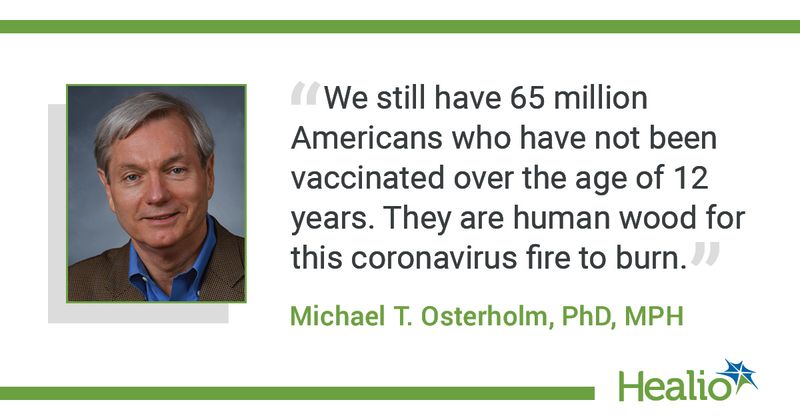New surges of COVID-19 ‘inevitable’ as millions remain unvaccinated
Click Here to Manage Email Alerts
Last month, in an interview with MSNBC, Peter J. Hotez, MD, PhD, warned that the state of Texas could see a fifth wave of COVID-19 right in time for the holidays.
Hotez, the dean of the National School of Tropical Medicine at Baylor College of Medicine and co-director of the Texas Children’s Hospital Center for Vaccine Development, referred to Texas’ low vaccination levels and the “screaming high” levels of transmission in the state as reasons for another possible surge in cases.

Likewise, the United States is also likely to see another increase, according to former CDC Director Tom Frieden, MD, MPH.

“A surge in cases is inevitable, and as long as there remains a sizeable unvaccinated population, we will continue to see surges,” Frieden, who now leads the Resolve to Save Lives initiative, told Healio.
As of Oct. 27, the 7-day daily average of new COVID-19 cases in the U.S. was 68,793 — a 7.4% decrease from the previous week. The 7-day daily average has been steadily decreasing since a recent Sept. 1 peak of 164,971 cases.
“Since the beginning of pandemic, we've seen these surges, and [is has] been particularly true with the delta variant,” Michael T. Osterholm, PhD, MPH, director of the Center for Infectious Disease Research and Policy at the University of Minnesota, told Healio. “They typically lasts 6 weeks to 2 months. When it hits an area hard, case numbers build, and then you can count on them — within that 6-week to 2-month period — to peak and come back down.”
According to Osterholm, the surges can be seen globally, and they appear to begin in people who remain unvaccinated.
“We are going to see more surges,” Osterholm said. “How big they will be, will be unclear, but we still have 65 million Americans who have not been vaccinated over the age of 12 years. They are human wood for this coronavirus fire to burn. That's a lot of people.”

Bruce Y. Lee, MD, MBA, professor of health policy and management at the City University of New York School of Public Health, likened the pattern to people trying to find a parking spot in a full lot — the virus is going to go wherever it can.
“Ultimately, the people who are most susceptible to the virus are people who have either not been protected via vaccine or have some immunity from having recovered from the virus,” Lee told Healio.
As health officials noted during the recent U.S. surge driven by the delta variant, cases were concentrated in areas with low vaccine coverage. Osterholm warned that people who believe they have “played out the clock” on the pandemic will not get through unscathed.
“It's just not true,” he said. “You can't wait the clock out on this one. If you are not protected from vaccine, or from infection, this virus will find you.”
Lee said it is not a question of if another variant will emerge, but when.
“The question is, what kind of variant may emerge and when?” he said. “The longer we wait, the more likely it is [that] a variant that actually may be more transmissible may emerge.”
There are “three buckets of concern” when it comes to variants, Osterholm said: that they will be more transmissible, cause more serious illness, or evade our immune protection from vaccination or infection.
“The one we've really emphasized and worried about has been the third one, understandably,” he said. “What happens if somehow it can defeat our protection we get from our vaccines?”
For Osterholm, a variant of that magnitude is hard to imagine.
“It’d be like having a measles virus on steroids,” he said. “Delta may be the king of the block for a while. If something does replace it that is much more transmissible, look out. That's not good.”
References:
CDC. COVID Data Tracker. https://covid.cdc.gov/covid-data-tracker/#trends_dailycases. Accessed Nov. 2, 2021.
Hotez PJ. Stephanie Ruhle Reports. Oct. 12, 2021.

